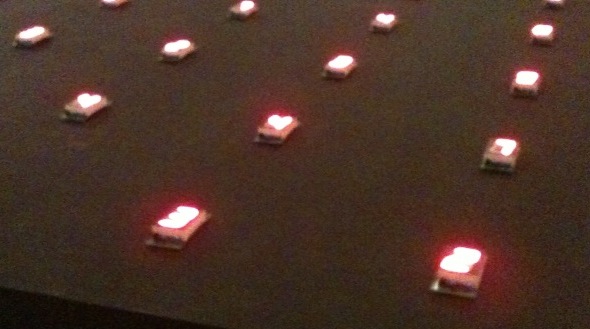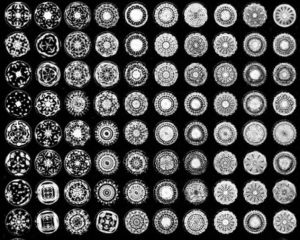
4-1/2 x 236-1/4 x 236-1/4 inches. © Tatsuo Miyajima. Image courtesy of the Dallas Museum of Art
I first saw Tatsuo Miyajima’s work in 1997 at his solo exhibition Big Time at London’s Hayward Gallery, when I was still training to be an Asian art historian. I had been focused on traditional Japanese art so was somewhat surprised by the hi-tech nature of his flickering LED artworks—so electronic and digital at a time when our lives and minds still hadn’t been sucked into the now-ubiquitous screens. My next encounter with his work was a decade later in 2008, when I traveled as a Japanese art study leader for an American museum art tour group to the Bennesse Art Site in Naoshima, one of Japan’s extraordinary art islands in the Inland Sea. There, several traditional Japanese homes—abandoned as younger generations leave the island—have become spaces for contemporary art, and Miyajima’s Sea of Time was the first. I remember being mesmerized by the dozens of flickering red LED counters arranged in a pool of water that filled the floor of a 200-year-old rustic building. On 2 January this year, I again sat contemplating his work at a solo exhibition at the Santa Barbara Museum of Art (SBMA) in California. The exhibition features four installations that evoke “infinite worlds of being, space, and time,” each with LED (light-emitting diode) counters repeatedly counting up from 1 to 9 or down from 9 to 1 at their own individual paces. As I cast my gaze over these illuminated digital artworks, I began reflecting on the space and time of my own life—and the fact that I had viewed Miyajima’s work over three decades and three continents. As I watched tiny red lights counting over and over again, I found myself settling comfortably into a new year of life and marveling at how something so mechanized could also be so meditative.

For Miyajima, such contemplation is very much a part of his life and his work, both of which are steeped in Buddhist thought. For several decades now, his philosophy on art and life has been: “Keep changing, connect with everything, continue forever,” embracing the Buddhist beliefs that life is constantly changing, interconnected, and infinite. As an artist, Miyajima originally trained in oil painting but soon rejected this art form as he found it not only alien to his culture and philosophy but also static, limiting his expressive potential. Instead he explored performance art but realized that the work of art ended with the performance, so he sought a way to create art that would perform continuously, interact with its space, and involve its audience. LED counters were the perfect medium for him to explore cycles, continuity, and change, with each sequence of 1–9 essentially representing a full lifecycle repeating again and again. In his repetitive sequences, instead of following the 9 with 0, Miyajima chose to include blank pause after the 9 and before the 1 of the next cycle. The dark emptiness created by this lack of a number serves as a pause or rest, evoking sleep or death, after which life begins again, a clear allusion to the Buddhist cycle of rebirth and the concept of reincarnation.
In Miyajima’s work Counter Ground, which was originally created for the Dallas Art Museum and is displayed on the gallery floor, the viewer has the experience of looking down on the expanse of lights as if beholding a city from a mountainside or perhaps even from the heavens. A sense of vibrant life and movement is created as gaps made by the pauses in the lifecycles of the counters form random patterns throughout the “city.” Close up, the viewer sees that in this installation, as in most of Miyajima’s works, the numbers count upwards from 1 to 9, creating a sense of expansion of life and energy.
In a very different and more recent work, titled Time Waterfall-panel #12 and created for the Lisson Gallery in London and New York, a tower-like column rests against the gallery wall, and large, purplish-white LED numbers flash on and off in a diagonally downward motion across the column’s surface. In this work, the numbers count downward from 9 to 1, echoing the downward flow of a waterfall but also symbolizing declining energy. Although this work is fascinating in its technical artistry and powerful in its symbolism, the brightly flashing lights and declining energy creates an unsettling effect—very likely intentional on the part of the artist. Gentle meditation in front of this work was impossible for this viewer, who soon retreated to the tranquility of Counter Ground.

graphics, LED display, 132-1/4 x 25-1/8 x 12-1/2 inches
© Tatsuo Miyajima. Image courtesy of Lisson Gallery
“Miyajima is one of the most important artists working today who bridges contemporary technology and human subjectivity, however one wishes to define that phenomenon,” explains Charles Wylie, curator of photography and new media at the Santa Barbara Museum of Art. Wylie speaks from a place of deep familiarity with Miyajima’s work. He has known him for more than 20 years and actually commissioned Miyajima to create the installation Counter Ground for the Dallas Art Museum in 1999, and was delighted to be able to bring a solo show of his work—for the first time in over 20 years—to the SBMA. “Tatsuo’s work is media-based but it is silent,” he adds. “This intrigues me because it promotes a kind of singular and personal concentration that is not needed with the machines we depend on daily.”
The work that perhaps most strongly expresses Miyajima’s Buddhist beliefs about the change, interconnectivity, and infinite in life is the square, wall-mounted work, Innumerable Life/Buddha MMMMCM-01, that is related to Counter Ground but was created 20 years later. Like the Time Waterfall series, Innumerable Life was created in 2018 for Lisson Gallery, but with its blood-red counters and upward number sequence, it shares the energizing, meditative quality of Counter Ground. With the hundreds of LED lights infinitely counting their varying upward cycles, Innumerable Life suggests the interconnectedness of individual lives within the multitude of lives in the universe. We are born, we live, we die, and then repeat the cycle to our own individual rhythms, while remaining connected to each other, forever and ever. What a powerful thought to carry with us into 2020—a year that seems so full of the potential for clarity and hopefully with it, peace too.

Light emitting diode, IC, electric wire, stainless steel, transformer.
LED type “Time Hundred” (Red) 49 plates; 69-1/2 x 69-1/2 x 5 inches
© Tatsuo Miyajima. Image courtesy of Lisson Gallery
The exhibition Tatsuo Miyajima is on display at theSanta Barbara Museum of Art until 19 April 2020. More about the artist can be found at his website.
See more













